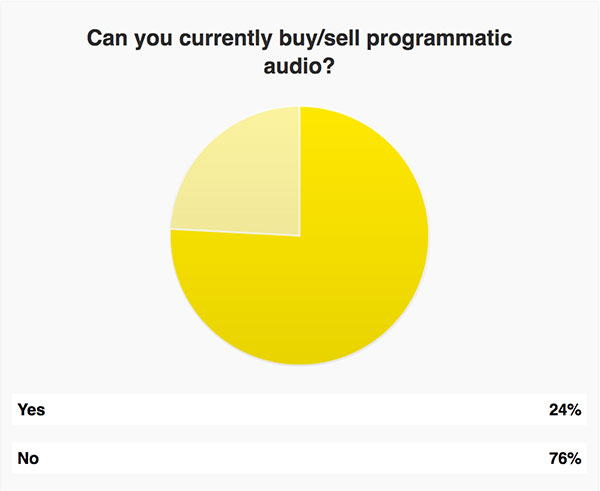Digiday Research: 24 percent of marketers can now buy or sell programmatic audio
This research is based on unique data collected from our proprietary audience of publisher, agency, brand and tech insiders. It’s available to Digiday+ members. More from the series →
Digiday’s “Research in brief” is our newest research installment designed to give you quick, easy and digestible facts to make better decisions and win arguments around the office. They are based on Digiday’s proprietary surveys of industry leaders, executives and doers. See our earlier research on the publisher pivot to video here.
A comprehensive report on 2016 U.S. advertising spend by the Interactive Advertising Bureau and PwC earlier this year found that digital audio produced $1.1 billion in ad revenue — the first time digital audio generated enough revenue to warrant its own reporting line. This accounted for roughly 2 percent of the $72.5 billion spent on digital advertising. Although seemingly small in comparison to display or video ads, digital audio ads have seen strong growth in recent years.
Fueled by programmatic, this growth should continue, according to Digiday’s recent poll of advertising executives at the Digiday Programmatic Summit Europe. Twenty-four percent of people claimed they could buy or sell programmatic audio.

Programmatic audio is becoming a bigger part of the audio and digital advertising market. Both SoundCloud and Spotify have expanded their programmatic audio offerings. Podcasting has steadily grown in popularity, bringing with it new advertising opportunities. A record 67 million Americans listen to podcasts every month, according to a 2017 study by Edison Research in collaboration with Triton Digital. Digiday’s Jessica Davies recently noted that legacy media players, including News UK, Bauer and Global Radio, have also ventured into programmatic audio.
Marketers like digital audio because of its high completion rates and low risk of ad fraud and brand-safety issues. Proponents of programmatic audio have further cause for optimism after a recent eMarketer study found that U.S. adults spend more time on mobile devices listening to digital audio than doing anything else. Devices like Amazon’s Alexa and Google Home will boost both streaming time and advertising, but there have been hiccups.
More in Media

Podcast companies turn to live events to capture growing advertiser spend
The surge in the number of live podcast events in 2025 reflects a broader shift: advertisers are betting bigger on podcasts — not just as an audio channel but as a full-fledged creator economy play.

Media Briefing: ‘Cloudflare is locking the door’: Publishers celebrate victory against AI bot crawlers
After years of miserably watching their content get ransacked for free by millions of unidentified AI bot crawlers, publishers were finally thrown a viable lifeline.

How Vogue could navigate potential industry headwinds as Anna Wintour — who agency execs say made ad dollars flow — brings on new edit lead
Anna Wintour’s successor at Vogue will have to overcome the myriad of challenges facing fashion media and the digital publishing ecosystem.





